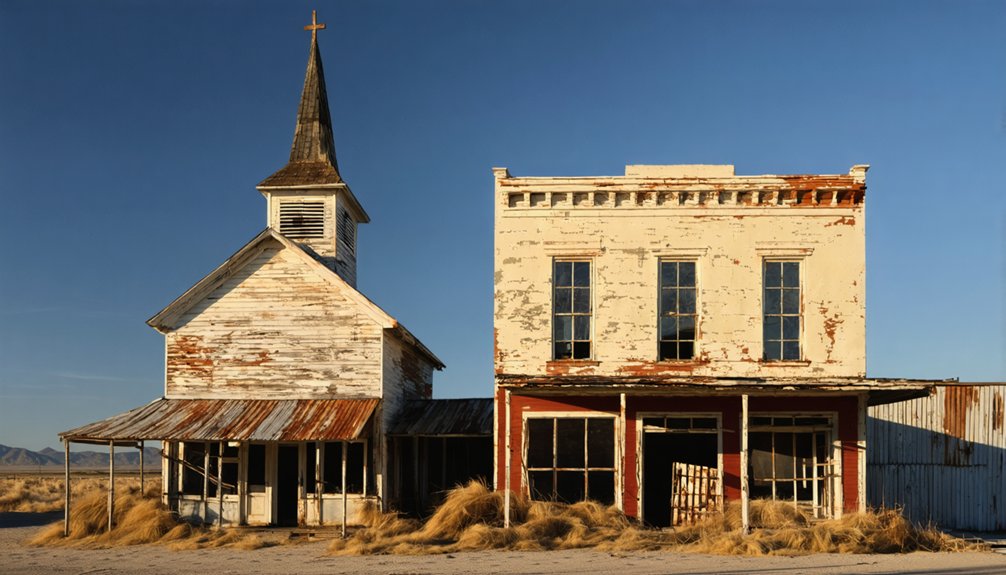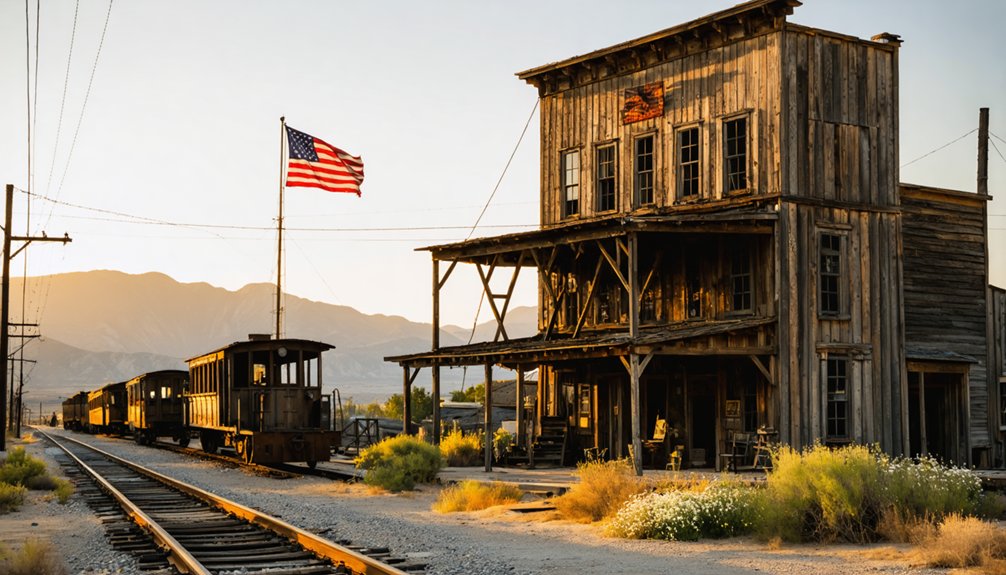Sedwell emerged after James Marshall’s 1848 gold discovery, quickly growing into a bustling boomtown with 8,000 residents and 400 businesses. You’ll find it was once a strategic location along the Mother Lode region with a diverse population of miners. As gold yields diminished, the town declined, facing devastating floods in 1861-1862 and frequent fires. Today, only fragments of hand-hewn timber frames and stone foundations remain, telling a deeper story of California’s transformative mining heritage.
Key Takeaways
- Sedwell began as a booming Gold Rush town after James W. Marshall’s 1848 discovery, growing to 8,000 residents with 400 businesses.
- Founded by James Sedwell, the town featured timber-frame buildings with stone foundations that now exist only as fragments.
- Hydraulic mining operations initially drove economic growth until gold deposits diminished, causing businesses to collapse.
- Catastrophic floods in 1861-1862 destroyed infrastructure, while fires and disease outbreaks accelerated the town’s decline.
- The abandoned settlement exemplifies California’s boom-and-bust mining town cycle, with most residents leaving as Oroville became the new county seat.
The Gold Rush Origins of Sedwell
When James W. Marshall discovered gold at Sutter’s Mill on January 24, 1848, he unknowingly triggered the birth of countless mining settlements—Sedwell among them.
Located in the gold-rich Sierra Nevada, Sedwell emerged as prospectors flooded into California, swelling the territory’s population from 14,000 to 100,000 by late 1849.
The town’s historical significance stems from its strategic position near placer deposits typical of the Mother Lode region. Gold’s unique physical properties made it easily identifiable among the stream sediments, aiding in its discovery and extraction.
As miners progressed from simple panning to more complex extraction methods, Sedwell mining operations evolved from individual claims to organized ventures. By 1853, many operations in the area had adopted hydraulic mining techniques that utilized high-pressure hoses to extract gold from hillsides.
The settlement grew to serve the diverse community of Argonauts—Americans, Europeans, Latin Americans, and Asians—all drawn by the promise of independence and prosperity in this mineral-rich frontier.
Life in a Mining Boomtown
As gold fever gripped California in the late 1840s, Sedwell transformed from a simple collection of tents into a bustling boomtown with a complex social hierarchy and economic structure.
You’d have found over 400 businesses operating during peak years, including saloons, hotels, and supply stores serving a diverse population that reached 8,000 residents.
Mining culture thrived as prospectors, merchants, and professionals established distinct community dynamics.
Walking through town, you’d see stock prices chalked on boards while investors anxiously watched their fortunes rise or fall.
The town’s four newspapers chronicled daily happenings while freight teams—sometimes 100 in a day—brought essential supplies.
Life remained harsh and transient, with residents constantly moving between strikes, creating an unstable yet vibrant society driven by dreams of wealth.
Mining speculation and economic fluctuations often led to financial panics that devastated communities like Sedwell.
Like many communities that ran out of gold, Sedwell eventually folded as miners abandoned the area in search of promising new strikes elsewhere.
Economic Rise and Fall
You’ll find that Sedwell’s economic trajectory followed the classic mining town pattern, with gold discoveries initially triggering explosive growth in businesses serving miners’ needs.
Trade along the Sacramento River further boosted the town’s prosperity, connecting it to larger commercial networks and facilitating the movement of goods and people. Similar to Cerro Gordo, the town’s remote location presented logistical challenges for residents and businesses alike.
As gold yields inevitably diminished, Sedwell’s boom-time business ventures collapsed, leaving behind empty storefronts and abandoned operations that stand as silent testimony to the ephemeral nature of resource-based economies. The residents endured impoverished conditions while pursuing their dreams of striking it rich, a common experience across mining communities of the era.
Gold’s Glitter Fades
The discovery of gold at Bidwell Bar by John Bidwell in 1848 sparked one of California’s earliest gold rushes, transforming a quiet stretch of the Feather River into a bustling economic center.
By 1856, approximately 2,000 fortune-seekers employed various mining techniques to extract placer gold from the riverbanks.
The town briefly served as the second county seat after Hamilton, highlighting its regional importance during the peak mining years.
Mining innovations such as the tom and improved sluice designs were adopted as placer mining evolved from individual efforts to organized operations requiring capital investment.
But the gold rush‘s prosperity proved fleeting. As accessible deposits diminished in the late 1850s, miners abandoned Bidwell Bar for more promising locations.
Oroville emerged as the new county seat in 1856, drawing away remaining businesses and residents.
The town’s economic significance faded as quickly as it had risen.
Boom-Time Business Ventures
Following the decline of mining operations, Sedwell’s commercial landscape transformed dramatically from 1852 to 1856. Entrepreneurs quickly identified investment opportunities in services supporting the remaining miners and transient population. General mercantiles, assay offices, and equipment suppliers initially dominated the business growth, with Porter’s Supply becoming the town’s commercial anchor.
By 1854, secondary enterprises emerged—saloons, hotels, and entertainment venues flourished as wealth circulated through the community. The Sedwell Banking Exchange facilitated transactions while speculators developed peripheral real estate. Transportation companies established regular stagecoach routes, connecting Sedwell to neighboring settlements. The economic pattern mirrored that of towns like Bodie, where poor resource management ultimately contributed to their decline. Similar to Cerro Gordo, Sedwell was eventually deserted for decades as the boom economy collapsed.
Unfortunately, these ventures depended entirely on extractive industry success. When silver veins narrowed in 1855, business failures cascaded. By 1856, half of Sedwell’s commercial district stood vacant—a stark reminder of how quickly frontier prosperity could vanish.
Sacramento River Trade
Waterways shaped Sedwell’s economic fortunes long before mining declined, with Sacramento River trade emerging as a critical lifeline for the region.
When John Sutter established New Helvetia in 1839, regular river navigation began connecting Sedwell to San Francisco’s markets. You’d have witnessed a revolution in transportation after 1848, when steamboats dramatically reduced the two-week journey time following Marshall’s gold discovery.
The river became Sedwell’s economic backbone as steamboats and barges transported miners, agricultural products, and construction materials along established trade routes. Local merchants flourished by positioning themselves along these waterways.
Notable Buildings and Structures

Remnants of frontier enterprise and community life define Sedwell’s architectural legacy, though little remains intact today.
The general store once served as the central hub for community interactions, while the post office connected this remote settlement to the outside world. Nearby stood a schoolhouse, saloon, and numerous timber-and-stone dwellings.
These structures showcased practical architectural styles typical of Sierra Nevada mining settlements. Buildings featured hand-hewn timber frames, locally quarried stone foundations, and corrugated metal or wooden shingle roofs.
Some cabins boasted rare stone fireplaces, while the saloon displayed a Western false front facade.
Now only fragments persist—scattered foundations, partial walls, and the occasional chimney.
The general store’s foundation and the schoolhouse site remain identifiable, silent witnesses to Sedwell’s once-vibrant community life.
The People Behind the Ghost Town
In Sedwell, you’ll find that miners endured grueling 12-hour shifts extracting gold and silver, often returning to cramped boarding houses or tent settlements at day’s end.
The town’s most influential figure, James Sedwell himself, established the first successful mining operation in 1853 before founding the town’s bank and newspaper by 1857.
Sheriff Thomas Blackwood maintained tenuous order throughout the 1860s, becoming legendary for his confrontations with the notorious Stillman Gang that repeatedly targeted the town’s gold shipments.
Daily Miner Lives
While historians have documented many California ghost towns in detail, Sedwell presents a unique challenge for researchers seeking to understand the lives of its miners. Unlike better-known abandoned settlements such as Bodie or Amboy, Sedwell’s historical record remains largely undiscovered in conventional research sources.
To uncover the authentic experiences of Sedwell’s miners—their mining tools, daily routines, and the presence of miner families—you’ll need to pursue alternative research avenues. Historical archives, county records, personal diaries, newspaper archives, and oral histories from descendants might yield insights unavailable through standard historical accounts.
The mystery surrounding Sedwell’s miners offers both a research challenge and an opportunity to contribute meaningful historical documentation to California’s rich mining heritage. This gap in documented history awaits your exploration.
Prominent Town Figures
Beyond the daily routines of miners lies a compelling cast of characters who shaped Sedwell’s brief but vibrant history.
Like similar boomtowns, Sedwell’s leadership emerged from enterprising individuals who controlled crucial resources and infrastructure.
Mining entrepreneurs established the town’s foundation, with figures comparable to Pablo Flores and Mortimer Belshaw wielding tremendous influence through claim ownership and transportation control.
These entrepreneurs often shifted into civic leadership roles, managing town governance and development decisions.
Store owners, hotel proprietors, and saloon keepers formed the social backbone, creating spaces where miners gathered after exhausting shifts.
Women, though often overlooked in historical records, ran essential businesses and boarding houses that kept the town functioning.
Local historians like those in other ghost towns now work to preserve Sedwell’s legacy, documenting the colorful characters whose ambitions built—and ultimately abandoned—this slice of California history.
Natural Disasters and Their Impact

Natural disasters played a decisive role in Sedwell’s eventual demise, striking the vulnerable settlement repeatedly throughout its short history.
The catastrophic floods of 1861-1862 transformed the Sacramento Valley into a 300-mile inland sea, washing away Sedwell’s infrastructure and forcing residents to elevate streets and buildings.
Fire hazards intensified during drought periods, destroying wooden structures and essential community records.
Earthquake risks, though minor, damaged mines and water systems, creating structural instabilities too costly for the struggling town to repair.
Drought effects severely limited water supplies, disrupting mining operations and creating resource conflicts among residents.
Disease outbreaks, particularly cholera and typhoid, spread rapidly due to contaminated water sources and poor sanitation, resulting in high mortality rates that accelerated population decline and discouraged new settlement.
What Remains Today: Exploring the Ruins
Today, Sedwell’s ruins stand as silent witnesses to its once-thriving past, offering visitors a tangible connection to California’s gold rush era.
As you explore the ruins, you’ll discover several wooden structures still standing—a general store, saloon, and miners’ cabins—while the roofless post office watches over the main street.
The partially accessible mine shaft entrance, accompanied by rusted ore carts and rail tracks, reveals Sedwell’s industrial heart.
Throughout the site, historical artifacts like mining tools, bottles, and occasionally personal items emerge after rainfall.
The landscape itself tells a story: tailings piles mark the mine entrance, while old wagon ruts trace forgotten routes between structures.
Though not officially maintained, these remnants provide an unfiltered glimpse into frontier life, free from modern intervention.
Sedwell’s Place in California’s Mining Heritage

Situated within California’s legendary gold rush landscape, Sedwell represents a microcosm of the state’s transformative mining heritage that began with the momentous 1848 discovery at Sutter’s Mill.
Sedwell stands as a living testament to California’s golden legacy, embodying the spirit that transformed a wilderness into legend.
As you explore California’s mining history, you’ll recognize how Sedwell’s position along the Feather River placed it at the heart of gold country, where John Bidwell’s early discoveries sparked regional development.
The town mirrors the technological evolution of gold extraction, from simple placer mining to more advanced hydraulic techniques that reshaped both the physical landscape and economic prospects of these communities.
Sedwell’s brief existence reflects the boom-and-bust cycle common to mining settlements while its cultural impact extended beyond economics—altering regional demographics and displacing indigenous populations like the Mechoopda, permanently changing California’s social fabric.
Frequently Asked Questions
Are There Any Haunting Stories or Legends About Sedwell?
No documented ghostly encounters or local lore exist for Sedwell. You’ll need to consult specialized historical archives or interview longtime residents to uncover any potential haunting stories from this California location.
How Accessible Is Sedwell to Modern-Day Visitors?
You’ll find Sedwell largely inaccessible, requiring off-road vehicles or hiking. No formal visitor guidelines exist for this ghost town, as it’s situated on potentially restricted land with no maintained infrastructure.
Was Sedwell Involved in Any Historical Conflicts or Violence?
Unlike nearby areas with documented incidents like the Sagebrush War, you’ll find no specific records of Sedwell conflicts or Sedwell violence in historical archives. Economic factors, not bloodshed, caused its abandonment.
What Valuable Artifacts Have Been Recovered From Sedwell?
You’ll find Sedwell’s artifact significance in recovered pewter containers, Levi’s jeans, antique bottles, metal valuables, and processed lead and silver remnants—treasures that legitimate archaeology preserves, unlike destructive treasure hunting practices.
Were Any Famous Historical Figures Associated With Sedwell?
Lost to history’s whispers, you’ll find no record of famous residents associated with Sedwell. Its historical significance remains undocumented in available records, leaving these pioneering spirits’ identities yet to be discovered.
References
- https://theazjones.com/the-ghost-town-of-helena-california/
- https://www.youtube.com/watch?v=5BEdAATx3ms
- https://blog.newspapers.com/a-summer-of-ghost-towns/
- https://www.camp-california.com/california-ghost-towns/
- https://dornsife.usc.edu/magazine/echoes-in-the-dust/
- https://en.wikipedia.org/wiki/List_of_ghost_towns_in_California
- https://www.californist.com/articles/interesting-california-ghost-towns
- https://www.visitcalifornia.com/road-trips/ghost-towns/
- https://www.youtube.com/watch?v=ElbXVNDurPc
- https://en.wikipedia.org/wiki/California_gold_rush



